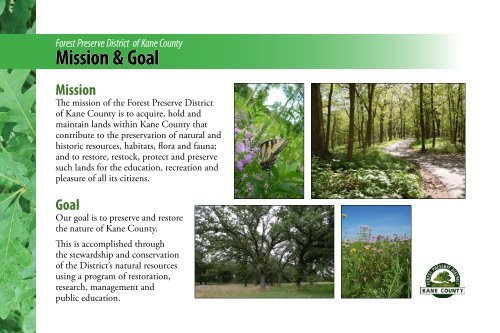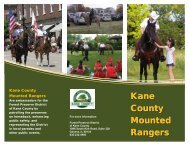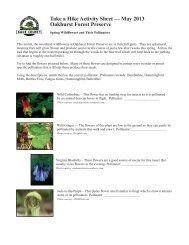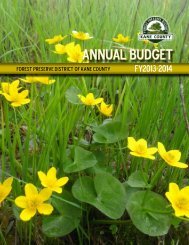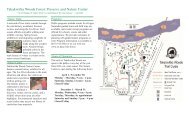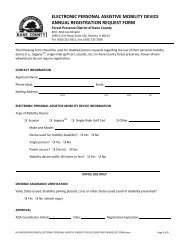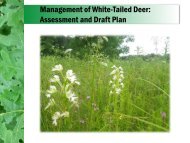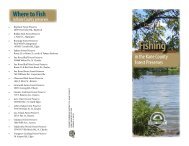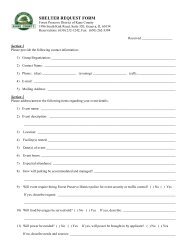Mission - Forest Preserve District of Kane County
Mission - Forest Preserve District of Kane County
Mission - Forest Preserve District of Kane County
Create successful ePaper yourself
Turn your PDF publications into a flip-book with our unique Google optimized e-Paper software.
<strong>Forest</strong> <strong>Preserve</strong> <strong>District</strong> <strong>of</strong> <strong>Kane</strong> <strong>County</strong><br />
<strong>Mission</strong> & Goal<br />
<strong>Mission</strong><br />
The mission <strong>of</strong> the <strong>Forest</strong> <strong>Preserve</strong> <strong>District</strong><br />
<strong>of</strong> <strong>Kane</strong> <strong>County</strong> is to acquire, hold and<br />
maintain lands within <strong>Kane</strong> <strong>County</strong> that<br />
contribute to the preservation <strong>of</strong> natural and<br />
historic resources, habitats, flora and fauna;<br />
and to restore, restock, protect and preserve<br />
such lands for the education, recreation and<br />
pleasure <strong>of</strong> all its citizens.<br />
Goal<br />
Our goal is to preserve and restore<br />
the nature <strong>of</strong> <strong>Kane</strong> <strong>County</strong>.<br />
This is accomplished through<br />
the stewardship and conservation<br />
<strong>of</strong> the <strong>District</strong>’s natural resources<br />
using a program <strong>of</strong> restoration,<br />
research, management and<br />
public education.
White-Tailed Deer<br />
Natural History & Biology<br />
White-tailed Deer<br />
(Odocoileus virginianus)<br />
• Males (bucks) usually weigh 150-250 pounds.<br />
• Females (does) usually weigh 100-150 pounds.<br />
• Mating occurs late October-January with a peak usually occurring in mid-November.<br />
• Females give birth to 1-3 young. Most are born from late May through mid-June.<br />
Diet<br />
• Deer are herbivores.<br />
• They feed mainly on herbaceous plants and the leaves, buds and twigs <strong>of</strong> trees and shrubs (browse).<br />
They also consume grasses, acorns (and other mast), agricultural crops, garden and ornamental plants.<br />
Deer Populations in Illinois<br />
• Nearly extirpated by habitat loss, and market and subsistence hunting by the late 1800s<br />
• Natural immigration occurred and restocking began in the 1930s.<br />
• By the late 1950s, a hunting season was allowed in 33 counties.<br />
• Presently, deer are abundant statewide and hunting is allowed in some form in every county.
White-Tailed Deer<br />
Factors in Overabundance<br />
Humans Alterations to the Landscape<br />
• Large predators <strong>of</strong> deer have been displaced or eliminated.<br />
• Urbanization and habitat<br />
loss have driven deer into<br />
smaller areas.<br />
• Fragmentation, and<br />
succession <strong>of</strong> habitats<br />
have created an ideal<br />
mosaic <strong>of</strong> forested and<br />
open areas (edge habitat)<br />
in which deer thrive.<br />
• Agricultural areas provide cover and large amounts <strong>of</strong> food<br />
for part <strong>of</strong> the year.<br />
• In urban and suburban areas, deer are becoming less<br />
exposed to hunting.<br />
Reproduction<br />
• Adult females usually have 2 fawns, but in some cases, can<br />
have 3-4 fawns.<br />
• With good nutrition, most yearlings do reproduce and<br />
some fawns may even reproduce.<br />
• In 5 years, a single doe could potentially contribute<br />
8 <strong>of</strong>fspring to the population.<br />
• Ideal habitat, good nutrition, mild winters,<br />
high survival and high reproductive rates<br />
are all factors contributing to high deer<br />
populations.
White-Tailed Deer<br />
Ecological Impacts<br />
Plant Conservation and <strong>Forest</strong> Regeneration<br />
• Deer are selective browsers and prefer certain plants over others.<br />
• Repeated browsing can affect the ability <strong>of</strong> plants to reproduce<br />
and persist (for instance, Trilliums and Orchids).<br />
• Sensitive plant species can decline or even disappear.<br />
• Overbrowsing can<br />
suppress the regeneration<br />
<strong>of</strong> desirable native<br />
tree species (oaks and<br />
hickories), leading to a<br />
shift in woodland tree<br />
composition.<br />
Trillium in flower next to numerous<br />
browsed stems<br />
Shade-tolerant species (maples) and invasive species (buckthorn)<br />
become more prevalent.<br />
• The conditions created by overbrowsing favor invasive species.<br />
Reforestation<br />
• Newly planted trees that are repeatedly<br />
browsed by deer have reduced growth and<br />
lower survival rates.<br />
• The <strong>District</strong> has planted 20,000 oak<br />
seedlings in the last 5 years as part <strong>of</strong> a<br />
long-term reforestation program.<br />
Other Species<br />
• The loss <strong>of</strong> plant species and structural diversity in the forest<br />
understory affects birds and other species who require these areas<br />
for food, nesting and cover.<br />
• The decline <strong>of</strong> native mastproducing<br />
species in the<br />
canopy will affect many species,<br />
including squirrels,<br />
chipmunks, mice, as<br />
well as deer. There<br />
will be less available<br />
Ovenbirds are one <strong>of</strong> various ground-nesting forest species<br />
food.
White-Tailed Deer<br />
Impacts on Human Safety & Property<br />
Deer Vehicle Collisions<br />
• High deer populations in areas <strong>of</strong> high human population<br />
increase the potential for deer-vehicle collisions.<br />
• <strong>Kane</strong> <strong>County</strong> averaged 510 deer-vehicle collisions reported<br />
per year, from 1994-2008.<br />
Tick-borne Diseases<br />
• Lyme disease: Deer are not the reservoir <strong>of</strong> the disease<br />
agent, but are the preferred host <strong>of</strong> the adult stage <strong>of</strong> the<br />
primary vector, the black-legged tick.<br />
• Babesiosis: This parasite affects blood cells in humans and<br />
can be severe. Deer are not the reservoir for this disease,<br />
but are the preferred host <strong>of</strong> the adult stage <strong>of</strong> the tick that<br />
spreads the disease, the black-legged tick.<br />
• Anaplasmosis: This bacterial infection affects white blood<br />
cells. It can be transmitted to humans by the black-legged<br />
tick. There are a wide range <strong>of</strong> hosts including deer, rodents<br />
and livestock.<br />
• These diseases are complex and involve many species, but<br />
deer play a role.<br />
Property Damage<br />
• Deer browsing and antler rubbing can cause economic<br />
losses to agricultural operations, orchards, and tree farms,<br />
as well as cause substantial damage to landscape and<br />
garden vegetation.
Deer Population Health<br />
Chronic Wasting Disease<br />
Chronic Wasting Disease (CWD)<br />
• CWD is a 100% fatal disease <strong>of</strong> the nervous system<br />
that affects deer and elk.<br />
• First found in Illinois in 2002, CWD was discovered<br />
in <strong>Kane</strong> <strong>County</strong> in 2010.<br />
• CWD is currently found in 4 <strong>Kane</strong> <strong>County</strong> townships.<br />
So far, 11 positive deer have been found in <strong>Kane</strong> <strong>County</strong>.<br />
• The primary transmission route is most likely direct<br />
contact (i.e., nose to nose). Growing evidence suggests<br />
indirect transmission is important as well (environmental<br />
contamination).<br />
• High deer populations are more conducive to the<br />
transmission and spread <strong>of</strong> CWD.
Research<br />
Aerial Counts<br />
Helicopter Surveys<br />
• Beginning in 2008, aerial counts have been conducted<br />
from a helicopter.<br />
• Aerial counts are conducted in winter, when adequate snow<br />
cover exists (more than 3 inches).<br />
• Two observers count deer, while transects are flown across<br />
an area.<br />
• Detection is imperfect. Aerial surveys typically<br />
underestimate the number <strong>of</strong> deer.<br />
60<br />
Deer per square mile<br />
50<br />
40<br />
30<br />
20<br />
10<br />
2008-2009<br />
2009-2010<br />
2010-2011<br />
Initial Goal<br />
0<br />
Oakhurst<br />
LeRoy Oakes<br />
Johnson's Mound<br />
Helm Woods<br />
Freeman Complex<br />
Dick Young<br />
Burnidge<br />
Burlington<br />
Brunner Complex<br />
Bliss-Hannaford<br />
Blackberry Maples<br />
Big Rock<br />
Aurora West
<strong>Forest</strong> <strong>Preserve</strong> <strong>District</strong> <strong>of</strong> <strong>Kane</strong> <strong>County</strong><br />
Land Management and Restoration<br />
Staff and volunteers use a variety <strong>of</strong> techniques to recreate and<br />
restore habitat, and to improve the resiliency <strong>of</strong> our natural<br />
areas, including:<br />
• Seed collection, propagation and sowing<br />
• Controlled burning<br />
• Invasive species control<br />
• Tree planting/reforestation
Deer Management<br />
Research<br />
Browse Studies<br />
• The <strong>District</strong> is currently<br />
monitoring woody<br />
browse, indicator species,<br />
special populations and<br />
reforestation plantings at<br />
several sites.<br />
• Outside research <strong>of</strong> <strong>Kane</strong><br />
<strong>County</strong> woodlands has also<br />
occurred over a 20-year period.<br />
• Research has found a decline in oak regeneration, a<br />
decrease in shrub species richness, an increase in the<br />
dominance <strong>of</strong> maples, and increases in invasive species.<br />
• Changes were attributed to reduced fire and disturbances,<br />
canopy closure and overbrowsing by white-tailed deer.<br />
• Woody browse surveys conducted thus far have recorded<br />
high levels <strong>of</strong> browse, shifting species composition,<br />
low presence <strong>of</strong> native shrub species, and low numbers<br />
<strong>of</strong> oak seedlings.
Deer Management<br />
How Are Similar Agencies Addressing This Issue?<br />
Deer<br />
Agency Management Sharpshooting Hunting<br />
<strong>Forest</strong> <strong>Preserve</strong> <strong>District</strong> <strong>of</strong> Cook <strong>County</strong> Yes Yes No<br />
<strong>Forest</strong> <strong>Preserve</strong> <strong>District</strong> <strong>of</strong> DuPage <strong>County</strong> Yes Yes No<br />
<strong>Forest</strong> <strong>Preserve</strong> <strong>District</strong> <strong>of</strong> Lake <strong>County</strong> Yes Yes No<br />
<strong>Forest</strong> <strong>Preserve</strong> <strong>District</strong> <strong>of</strong> Will <strong>County</strong> Yes Yes No<br />
McHenry <strong>County</strong> Conservation <strong>District</strong> Yes Yes Yes<br />
Boone <strong>County</strong> Conservation <strong>District</strong> Yes No Yes<br />
<strong>Forest</strong> <strong>Preserve</strong> <strong>District</strong> <strong>of</strong> Winnebago <strong>County</strong> Yes Yes No<br />
<strong>Forest</strong> <strong>Preserve</strong> <strong>District</strong> <strong>of</strong> Rock Island <strong>County</strong> Yes No Yes<br />
<strong>Forest</strong> <strong>Preserve</strong> <strong>District</strong> <strong>of</strong> Kendall <strong>County</strong> No No No
Deer Management<br />
Need for a Program<br />
• Growing deer populations are a concern in <strong>Kane</strong> <strong>County</strong><br />
and across the 8-county Chicago region.<br />
• Population levels are increasingly at odds with maintaining<br />
plant diversity in natural areas, and at times, impact the<br />
safety and property <strong>of</strong> the public.<br />
• We have deer populations that are higher than most<br />
conservation agencies manage for, to maintain diverse<br />
and sustainable ecosystems.<br />
• There is evidence <strong>of</strong> ecological impacts in some <strong>of</strong><br />
<strong>Kane</strong> <strong>County</strong>’s finest natural areas.
Deer Management Program<br />
<strong>Mission</strong> & Goals<br />
<strong>Mission</strong><br />
The mission <strong>of</strong> the program will be to maintain and enhance<br />
the diversity <strong>of</strong> flora and fauna within preserves. The program<br />
shall protect natural and restored plant communities from<br />
excessive deer impact by managing deer populations at levels<br />
compatible with the long-term health <strong>of</strong> ecosystems, using safe,<br />
effective and state-approved methods.<br />
Goals and Objectives<br />
• Natural Resources Goal: Manage and maintain a healthy,<br />
stable deer population, appropriate to the habitat present at<br />
<strong>District</strong> preserves.<br />
- Population Objective: Establish population levels<br />
for deer at each site or complex <strong>of</strong> preserves.<br />
- Ecological Impact Objectives: Establish site or<br />
complex-specific objectives related to habitat, plant<br />
communities and restoration efforts, to preserve<br />
and enhance native plant communities and their<br />
associated fauna.<br />
• Public Safety Goal: Enhance the safety <strong>of</strong> the public<br />
through management, where necessary.<br />
- Public Health and Safety Objectives: Establish site or<br />
complex-specific objectives related to the enhancement<br />
<strong>of</strong> the health and safety <strong>of</strong> the public. Reduce deervehicle<br />
collisions in management areas. Research<br />
zoonotic diseases.<br />
• Communication Goal: Maintain communication<br />
with preserve users and neighbors.<br />
- Communication Objective: Maintain<br />
communication with the public regarding<br />
deer management activities, current research<br />
and information for resolving deer issues.
Deer Management Program<br />
Non-Lethal Options<br />
Take No Action<br />
• There would be implications in the long term on vegetation<br />
structure and diversity, sensitive and rare species, habitat<br />
quality, wildlife, and human health and safety with this<br />
option.<br />
• We must accept that high-quality ecosystems will be<br />
degraded by intense deer browsing.<br />
• Attempts to restore other areas with the influences <strong>of</strong> high<br />
deer densities would be a consideration.<br />
• This option is not compatible with the <strong>Forest</strong> <strong>Preserve</strong><br />
<strong>District</strong>’s mission or its duty to be responsible stewards<br />
<strong>of</strong> public lands.<br />
Apply Frequent Repellents<br />
• This option requires frequent, yearly application.<br />
• Application is time- and labor-intensive.<br />
• Repellents cost approximately $100 per gallon and<br />
can treat roughly 400 tree saplings.<br />
• Repellents also appear to decline in efficacy when deer<br />
populations are high, as feeding pressure can overcome the<br />
repellents’ effects.<br />
Install Extensive Fencing<br />
• This option restricts movements <strong>of</strong> many species,<br />
not just deer.<br />
• Installing fencing is costly. Recently, 2,200 linear feet<br />
<strong>of</strong> 8-foot fence was quoted at $55,000.<br />
• Fencing or caging can be used to protect small, rare<br />
populations, but is not practical on large scales due to cost,<br />
roads, streams, utility right <strong>of</strong> way, etc.<br />
• Extensive fencing would degrade the aesthetic<br />
qualities <strong>of</strong> our natural areas.
Deer Management Program<br />
Non-Lethal Options<br />
Trap and Relocate<br />
• Mortality rates <strong>of</strong> 66% to 85% have been reported within<br />
1 year, post relocation.<br />
• In 1990-1991, the Lake <strong>County</strong> <strong>Forest</strong> <strong>Preserve</strong> <strong>District</strong><br />
reported costs <strong>of</strong> $603 to $1,261 per relocated deer.<br />
• Potential to spread diseases like Chronic Wasting Disease.<br />
• The Illinois Department <strong>of</strong> Natural Resources (IDNR)<br />
will not issue deer population-control permits for this<br />
method.<br />
Fertility Control<br />
• Methods: surgical sterilization, hormone implantation,<br />
immunocontraception<br />
• Surgical sterilization requires a veterinarian and the capture<br />
<strong>of</strong> each doe. Costs are reported at $1,075 per deer, in a<br />
recent Cornell project.<br />
• Immunocontraception requires the darting or capture <strong>of</strong><br />
each doe.<br />
• To cause a decline in population growth over time,<br />
70-90% <strong>of</strong> females need to be treated.<br />
• Immunocontaceptives currently require multiple<br />
treatments over time.<br />
• The cost <strong>of</strong> labor, materials and the feasibility <strong>of</strong> treating<br />
an adequate number <strong>of</strong> deer will likely limit the use <strong>of</strong><br />
immunocontraceptives to small, insular herds that are<br />
habituated to humans.<br />
• IDNR will not issue deer population-control permits<br />
for experimental techniques.<br />
Supplemental Feeding<br />
• State law prohibits the feeding <strong>of</strong> deer.<br />
• Could encourage increased reproduction,<br />
which would increase ecological impacts.
Deer Management Program<br />
Lethal Options<br />
Reintroduce Predators<br />
• Coyotes are the primary predator <strong>of</strong> deer in northern<br />
Illinois, but they generally take fawns.<br />
• Reintroducing large predators (wolves or mountain lions)<br />
that would commonly take adult deer is impractical<br />
for ecological (lack <strong>of</strong> large habitat areas), social (safety<br />
concerns), and legal reasons.<br />
Controlled Archery Hunting<br />
• Use hunting as a management tool during the legal season<br />
(Oct 1- Jan 20) by IDNR.<br />
• Controlled hunts allow additional rules and restrictions to<br />
address safety concerns and other issues unique to each site.<br />
• Program costs can be covered by user fees, rather than tax<br />
revenue.<br />
Sharpshooting<br />
• This option must be conducted under a Deer Population<br />
Control Permit (DPCP) from IDNR.<br />
• Sharpshooting entails the culling <strong>of</strong> deer at pre-selected<br />
locations, when preserves are closed to the public.<br />
• Deer must be processed and donated to charity.<br />
• Processing costs range from $30-$60 per deer.<br />
• Existing staff can be qualified as marksmen and<br />
markswomen, to limit personnel costs incurred.
Deer Management<br />
Proposed Methods<br />
Current Status<br />
The <strong>District</strong> is already using non-lethal means (i.e., repellents<br />
and limited fencing) to mitigate deer impacts where practical<br />
and applicable.<br />
It is impossible to implement these methods over large areas,<br />
such as 1,000+ acre preserves.<br />
Currently, a field-proven, state-approved non-lethal means to<br />
reduce overabundant free-ranging deer populations does not<br />
exist.<br />
Proposed Methods<br />
When necessary, lethal removal <strong>of</strong> deer is the most-viable<br />
option and is the staff-recommended approach for reducing<br />
deer densities across specific, not all, <strong>District</strong> lands. This<br />
option is the most practical and effective means to manage deer<br />
populations and shall best maintain them at levels compatible<br />
with long-term conservation objectives.<br />
The two primary lethal means <strong>of</strong> removal recommended are:<br />
1) Controlled archery hunting within the established deer<br />
hunting seasons.<br />
2) Sharpshooting under a Deer Population Control Permit<br />
from IDNR.<br />
These methods are not mutually exclusive, and depending<br />
on the location and other factors, controlled<br />
hunting can be utilized initially or during the<br />
“maintenance phase” <strong>of</strong> deer management, after<br />
sharpshooting in the “reduction phase.”
Deer Management<br />
Proposed Methods<br />
Controlled Archery Hunting<br />
• Safety would be the top priority <strong>of</strong> the program.<br />
• If approved, controlled hunts would be conducted within<br />
the season established by IDNR.<br />
• Program participants must comply with rules and regulations<br />
by the IDNR as well as the <strong>Forest</strong> <strong>Preserve</strong> <strong>District</strong>.<br />
• Pro<strong>of</strong> <strong>of</strong> completion <strong>of</strong> an approved hunter safety course<br />
would be required.<br />
• Participants would be required to attend an orientation<br />
meeting and qualify during an archery pr<strong>of</strong>iciency test.<br />
• Program participants would be chosen by a lottery open<br />
only to <strong>Kane</strong> <strong>County</strong> residents.<br />
• The <strong>District</strong> would establish management zones based on<br />
available habitat, preserve boundaries, trails, access points,<br />
and recreational, residential and other developed areas.<br />
• A fee structure will be established to help <strong>of</strong>fset the cost<br />
<strong>of</strong> managing the program.<br />
• The collection <strong>of</strong> a sample for Chronic Wasting Disease<br />
testing would be mandatory for participation.<br />
Sharpshooting<br />
• Safety would be the top priority <strong>of</strong> the program.<br />
• If approved, sharpshooting would take place in areas that<br />
cannot accommodate controlled hunts or where controlled<br />
hunts alone are not sufficiently reducing the deer population.<br />
• The <strong>District</strong> would comply with all regulations and<br />
requirements <strong>of</strong> the IDNR’s Deer Population Control Permit<br />
(DPCP).<br />
• Marksmen and markswomen would be required to<br />
successfully complete the IDNR qualification process.<br />
• Sharpshooting activity would be implemented while<br />
preserves are closed, to allow normal preserve<br />
use and ensure public safety.<br />
• The venison from all deer taken under a<br />
DPCP would donated to food pantries and<br />
charitable organizations, as is required.
Brook<br />
Gary<br />
Deer Management Program<br />
Preliminary Site Identification<br />
Brunner Family<br />
Freeman Kame<br />
Lundstrom<br />
Winaki<br />
Nokomis<br />
Meghan<br />
Teri<br />
Charles<br />
Riverwood<br />
White Chapel<br />
Crescent<br />
<strong>Forest</strong><br />
Lathrop<br />
Illinois Route 31<br />
Longcommon<br />
Angelina<br />
Bolz<br />
Ridgefield<br />
Huntley<br />
Barko<br />
Aztec<br />
West Hill<br />
Ridge<br />
Parsons<br />
Country School<br />
Algonquin<br />
Melody<br />
Oxford<br />
Castlewood<br />
Kings<br />
Lake Shore<br />
Carriage Way<br />
Gabrielle<br />
Adam<br />
Brotto<br />
Hannah Pearl<br />
Powers<br />
Freeman<br />
Mary<br />
<strong>Forest</strong> Trail<br />
Sunburst<br />
Blue Aster<br />
Galligan<br />
Miller<br />
Paperbark<br />
High Ridge<br />
Oak Knoll<br />
Commerce<br />
Sunset<br />
Skyline<br />
Binnie<br />
Park<br />
Koppie<br />
South Wind<br />
Lake Marian<br />
Huntley<br />
Harbor<br />
Anchor<br />
Rivers View<br />
Elm<br />
Western<br />
Fox River<br />
Lincoln<br />
Wisconsin<br />
Main<br />
Lord<br />
Green<br />
Maple<br />
Grove<br />
Day<br />
Memory<br />
Thatcher<br />
River Bluff<br />
Spring<br />
Park<br />
Williams<br />
Oak<br />
Vana<br />
Carpenter<br />
Goethe<br />
Windham<br />
Tamarac<br />
Cleveland<br />
Deer Hill<br />
Wilmette<br />
Rosewood<br />
J<br />
Brookdale<br />
Big Timber<br />
Tower Hill<br />
I-90<br />
Illinois Route 72<br />
Toll View<br />
Tyler Creek<br />
Park<br />
Industrial<br />
Willey<br />
Jackson<br />
Higgins<br />
Tyrrell<br />
Center<br />
Town Center<br />
J<br />
Elgin<br />
Sola
Deer Management Program<br />
Summary<br />
• Similar to other urban and suburban areas in the Chicago<br />
area and throughout the United States, there is evidence<br />
<strong>of</strong> elevated deer populations at many <strong>District</strong> properties.<br />
• Some populations are well above levels, where other<br />
conservation agencies have observed substantial impacts<br />
to natural areas.<br />
• There is evidence <strong>of</strong> ecological impacts in some<br />
<strong>of</strong> <strong>Kane</strong> <strong>County</strong>’s finest natural areas.<br />
• Responsible stewardship and natural resource management<br />
require that we manage our natural areas for the long-term<br />
benefit <strong>of</strong> all species.<br />
• Having evaluated the options currently available for<br />
managing deer populations, controlled archery hunts and<br />
sharpshooting are the only safe, effective and state-approved<br />
means for reducing free-ranging deer populations.<br />
• Deer management is not a one time event,<br />
it is a long-term commitment.


